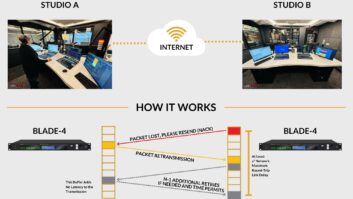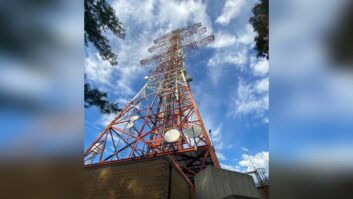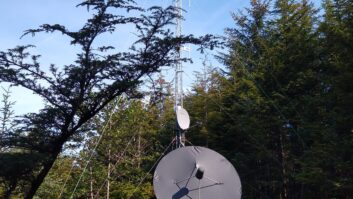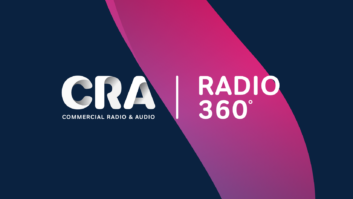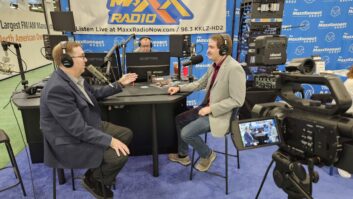Bigger Is Better
Jun 1, 2005 12:00 PM, By Allen J. Singer

How can seven employees get their work done in a radio station that is so small, there is literally no room for them to do their work? With great difficulty. This is the problem that plagued tiny talk-station 1160-AM, WMET in Gaithersburg, MD. The lack of space in its 700 square-foot suite built in the early ’90s had become such a nuisance its sales staff and station manager had no choice but to work from home. WMET contained enough room for only an on-air studio and production room. And located inside the production room were the kitchen, a waiting room and the station’s only office. There was no room for staff, no room for more than two people participating in a talk show and no room for any kind of expansion.
Somewhat a rarity even in the 1990s, WMET was owned by one person; when it was built, the station really did not need much room. Its format was talk radio, and its staff was minimal. By the end of the decade, the equipment in use included aging Tascam reel decks, consumer-grade minidisk and cassette decks, a BTSG automation system, and surprisingly, no cart machines. But what made matters worse was that quite a few engineers had traversed the hallways over the ’90s, resulting in poor wire labeling and minimal planning. Setting equipment levels and troubleshooting problems were nearly impossible.
Changes abound
Looking into master control as you enter.
The WMET talk studio comfortably seats six people.
The call screen booth is at the rear of master control.
Production Director Jim Cuddy works in main production.
The audio, control and telephone cross connect blocks are on the wall behind the racks.
The rack room houses the servers, audio router and other equipment.
IDT Capitol, a telecom, entertainment and technology company, bought WMET in 2001. With a large budget and full support from its new ownership, management made immediate plans to move the station out of its hole in Gaithersburg and into a brand new showcase studio 20 miles away in downtown Washington DC. A larger facility and close proximity to the nation’s capital would allow WMET better access to guests from the government and other national offices. And if WMET was going to successfully obtain the business it needed to survive, the station required a larger physical area for its proposed increase of offices and personnel. IDT owned some office space in a suitable building just seven blocks from the White House.
The downtown site was deemed perfect for a new facility and IDT gave them the keys. Working with management and fellow staff members, Chief Engineer Brian Rose surveyed the available 6,000 square-foot office space and created floor plans with CAD. He designed the facility around the talk studio, selectable via router in the three different studios. This setup offers flexibility for live programs and prerecording shows to be aired later. The offices wrap around the studio, designed so support staff could be more closely involved in on-air operations.
Management hired OTJ Architects of Washington, DC, to translate Rose’s drawings into blueprints, and local general contractor Corbett Construction went to work in December 2003. In three months the shell of the facility was built. Through the next few months, Rose and two contract-engineering companies installed the studios and equipment. During this time, the furniture was brought in and offices were equipped. At any given time, they had between five and 30 people working depending on the day and the task.
Overall, the project went smoothly except for a problem with the HVAC system. The rack room and studio needed more cooling than the building could handle, so they had to install three additional units totaling 15 tons of cooling for the studio area. Some materials used in this construction had to be custom-built, which caused them to get behind schedule. The HVAC now includes two separate units for the studio and office spaces with an additional five-ton cooler just for the rack room. Also, the station had a slightly bumpy ride during the switchover in November 2004 due to telecom issues with its T-1 line and the PRI service for the phone system. Once those problems were ironed out, WMET went fully live from Washington, DC.
Flexibility first
The new WMET facility consists of a main on-air control room, a talk studio usable by any studio, two production rooms and a rack room. All studios and their support rooms including mechanical and electrical take up about 2,000 square feet. Combinations of sound-dampening materials were used in the studio walls. Acoustics First 1014 Acoustikits were installed as wall treatments. Inside the walls are a vinyl barrier between two sheets of sheetrock and the walls are covered with Acoustics First wall fabric. WMET now enjoys sound isolation like it never could have had before.
All of the studios received new equipment; nothing from the old facility was salvaged. A Wheatstone Bridge Router with 112 inputs and 128 outputs was installed to carry the analog and digital audio throughout the complex on traditional snake cable. Unlike other modern installations, at WMET CAT-5 cable only carries control signals � no audio. A custom-built patch bay for all router inputs and outputs on XLR was located in the studios and rack room. An OMT Imediatouch automation system was installed. This system includes the Oplog32 On-Air, Production, Logger, Adcast and Log Tools modules. It was chosen for its past performance at Liberty Broadcasting. CBSI was chosen to handle traffic.
The main control room contains a new Wheatstone D-8000 console, chosen for its similarities to the analog consoles the staff was familiar with, but containing advanced features and capabilities needed for running the station’s talk format. Wheatstone D-16 consoles were installed in the production studios, which gives staff the flexibility of digital but functionality of an analog console. Because the consoles can share audio and closures, the necessary audio sources, including satellite and station program feeds, were placed into each of the control rooms. Otherwise, production rooms contain everything they need, except one production room contains an additional microphone for host or voice talent. An added green room looks through the main control room into the talk studio, and the call screen booth has a line-of-sight and IFB to the board-operator and host.
A Harris Intraplex frame with a full T-1 takes the program audio to the transmitter site located in Gaithersburg. The T-1 carries digital and analog audio to the transmitter site, and includes six channels of satellite audio brought back from the satellite dish at the transmitter site. Four channels of serial data also ride on the T-1 line, as well as an extension of the studio LAN.
When the facility was finished during the winter of 2004, the staff moved in. It wasted no time acclimating to the new router system and digital workstations located on operations staff desks. Although the project took a little longer than planned, the end result is an efficient, more productive work environment. The studios and offices are eight times larger than their old, cramped facility, and the staff of 25 is having no trouble finding elbow room. Using their new studios and new equipment, the locally produced shows sound much different, and their on-air product has a noticeably fuller sound than before. Aside from the usual tweaking and adjusting of software templates, the new production and automation software is working great. Station breaks and show elements fit together much cleaner now, and station imaging shows prominent improvement.
Coming in the spring of 2005, WMET will add a voice booth and another production room for spot and imaging production. And with its increase of power to 50,000W in the summer of 2004, the station’s signal now reaches from Richmond, VA, to Baltimore, MD, with access to millions of new listeners. WMET promises to blend �substance and style� to deliver serious radio to its DC audience. The station’s mission is much easier now that the staff doesn’t have to worry about doing their jobs in the kitchen. The only thing they’ll miss from their Gaithersburg location is the luxury of having the refrigerator at arm’s length while they work on production.
Equipment List
Acoustics First 1014 Acoustikits
Airtools 6100 delay
Behringer HA4400 headphone amplifiers
Electro-Voice RE27 ND microphones
Focusrite OctoPre and Voicemaster mic processing
Furman MS2AD1 confidence monitors
Furman PL-Plus power conditioners
JBL 4410 monitors
LPB Silent Mic Boom microphone booms
Mackie HR824 powered studio monitors
M-Audio BX8 powered studio monitors
OMT Adcast, Logger, LogTools, Oplog32 and Production
QSC CX 2 amplifiers
Sennheiser headphones
Shure KSM27
Sony CDP-12 CD players and MDS E-10 Minidisc
Telos 2�12 phone system w/ Assistant Producer
Telos Zephyr
Tieline POTS and ISDN codecs
Wheatstone Bridge router, D-16 console and D-8000 console
Singer is a freelance writer and former radio engineer in Cincinnati.








